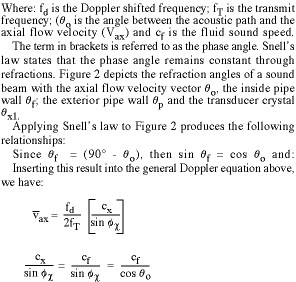

Clamp-on ultrasonic Doppler flowmeters are used in a wide variety of industrial, chemical, wastewater and food processing applications. Understanding how these nonintrusive flowmeters work will help you to understand when to use them.
For slurries, dispersions and emulsions, drag forces are largely dependent on particle size and density relative to the fluid. Drag forces compel particles to travel at the same velocity as the fluid. Flow disruptions from devices, such as elbows, valves and reducers, can slow or stop large numbers of particles. The real concern is recovery time or distance to return to full fluid velocity. When studying various diameters of solid, spherical particles of a density 2,5 times that of water, the first observation is that minor velocity disruptions (tens of mm/s), such as those that occur when particles collide, recover very quickly to flow velocity. This is due to the high drag forces generated in the lower laminar flow regime. The specific gravity of 2,5 is common for sand and gravel. Even large particles of diameter 7,5 mm, recover to flow velocity from a complete stop in approximately 300 mm. Because Doppler flowmeters average reflections from particles flowing near the centre of the pipe, particles impacting on the pipe wall will return to full flow velocity by the time they reach the pipe centre. This model assumes fluid flow turbulence does not effect particle boundary separation.
Conclusion
For horizontal flow, most particles of reasonable size and density travel at the same velocity as the fluid.
Special cases
Upflow
For sledges and emulsions, upflow is not an issue. The sonic material travels at the same velocity as the fluid. For slurries or 'dispersions', the force of gravity acts against the drag force. If the velocity is high enough, the particles will reach equilibrium at the terminal velocity, which will be less than the fluid velocity. How much less is determined by particle size, density relative to the fluid and fluid viscosity. Figure 1 shows the terminal velocity for spherical particles in water. The different lines indicate particles of differing specific gravity, with 2 to 2,5 being normal sand and gravel densities. The discontinuity in the curves is due to an abrupt change in the separation boundary at Re = 1000.
As an example, large sand particles are 0,5 mm in diameter and SG = 2. The terminal velocity is 0,06 m/s. This is the minimum velocity required to keep the sand from falling down the pipe. This is also the error to expect at higher flows. If the fluid velocity were 1,54 m/s, the Doppler flowmeter would read 4% low. This model is based on flow travelling over solid spherical particles; however, it gives a reasonable indication of the particle to fluid velocity difference.
At the other end of the scale, glass marbles (SG = 2,5) of 13 mm diameter would reach terminal velocity at 0,8 m/s less than the fluid velocity. It also follows that the minimum velocity must be greater than 0,8 m/s to advance the particles up the pipe. At velocities less than 0,8 m/s, particles will begin to travel down the pipe due to the force of gravity. In a real application of this particle size and density, the flow velocity should be much greater than 0,8 m/s to keep particles of this size and density moving up the pipe. It should be noted that in applications measuring flow with large particles, it is often the particle velocity that is of primary interest, rather than fluid flow. An example is dredging lakes and rivers, where the interest is in how much solid material is removed. The error in water flow is irrelevant.
Bubbles
In the past, when Doppler flowmeters were the only clamp-on ultrasound meters available, they were often recommended for clean liquids if air bubbles were present. Air bubbles make good sonic reflectors if the source is reliable. In a newly commissioned flow system, the fluid will often contain entrapped air, which will provide excellent sonic scatterers for a Doppler flowmeter. But, as the system operates, the entrapped air is slowly expelled out of the fluid and the signal strength of the Doppler flowmeter slowly decreases to failure (this may take weeks). Also, bubbles have a 1/1000 density difference with water, which raises the question of accuracy. The terminal velocity of bubbles in water is relatively linear with bubble diameter, such that a 5 mm bubble has a terminal velocity of 0,62 m/s and a 2,5 mm bubble, 0,31 m/s etc. These terminal velocities can cause serious flow measurement errors in upflow applications. Even in horizontal pipe flow, the bubbles can drift toward the top of the pipe over long straight runs, causing velocity errors.
Another concern is too much air entrained in the liquid. The sonic velocity of the fluid can be reduced so severely that no ultrasound can be propagated. Sound speed of the air-water mixture actually drops below the sound speed of pure air (330 m/s), at 0,1% air by volume.
Excessive air content is a common cause of ultrasound flowmeter application failure. The Doppler flowmeter is the most tolerant of all ultrasound meters to aeration, and can tolerate about 0,05% air by volume before signal is lost.
Temperature effects
Clamp-on Doppler flowmeter accuracy is unaffected by the sound speed of the pipe, or the flowing fluid, nor is it affected by changes in fluid sound speed caused by temperature or fluid makeup. This insensitivity is inherent in the physics, and is explained by studying the following general Doppler equation:

The Doppler velocity measurement is only dependent on the angle and sound speed of the transducers, which, of course, are known. The pipe and fluid sound speed and angles have no effect on the velocity measurement. It follows that changes in the fluid sound speed, due to composition or temperature changes, have no effect.
Conclusions
Doppler flowmeters are a cost-effective, nonintrusive solution to measuring flow in full pipes carrying fluids with useful sonic scatterers, such as sludges, slurries, emulsions, dispersions and pulps. These categories encompass a wide variety of industrial, chemical, wastewater and food processing applications. Some representative applications are listed below.
Municipal: sludge, wastewater.
Food production: wine, beer, juices, coffee, chocolate, tomato products, hot sauce, soup, raw milk, sugar and egg products.
Industrial: coal slurries, dredging operations, stack scrubber slurries, pulp stock, mining slurries and crude oil.
Fluids with useful sonic scatterers
Slurry: Solids dispersed in a liquid, where the solid density is greater than the liquid. The solids can be separated by settling or centrifugal action.
Pulp: Usually organic solids in a liquid, where the solid density is less than the liquid. Solids float to the surface when the liquid is left stagnant.
Sludge: Precipitated solids matter produced by water and sewage treatment processes. Solids are of the same density as water, and are not easily separated.
Unstable dispersion: Liquid/liquid mixture, where droplet diameters are 1 mm or greater, and liquids separate rapidly when left stagnant.
Emulsion: A stable liquid/liquid dispersion, with droplet diameters less than 100 micrometres (or 0,1 mm)
Colloidal suspension: A stable system, with particle sizes less than five microns (Note: Colloidal systems such as paint, generally cannot be measured by clamp-on Doppler flowmeters.)

© Technews Publishing (Pty) Ltd | All Rights Reserved